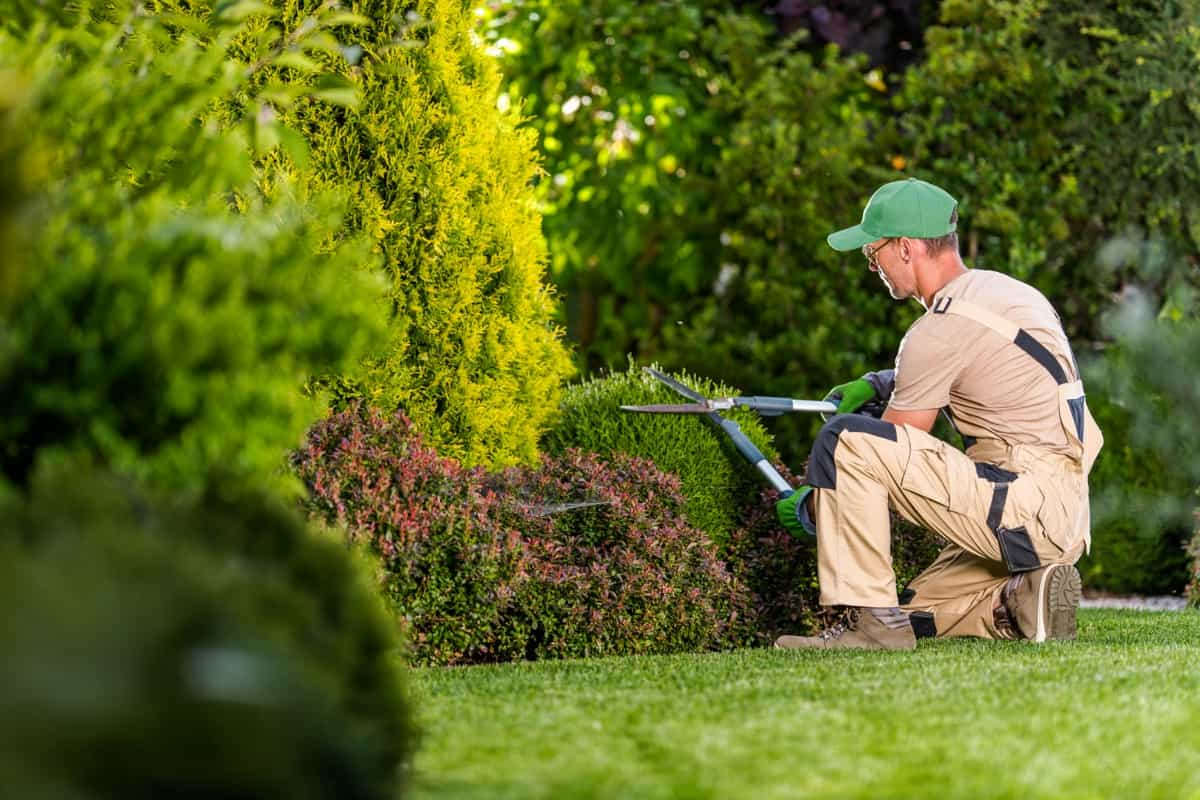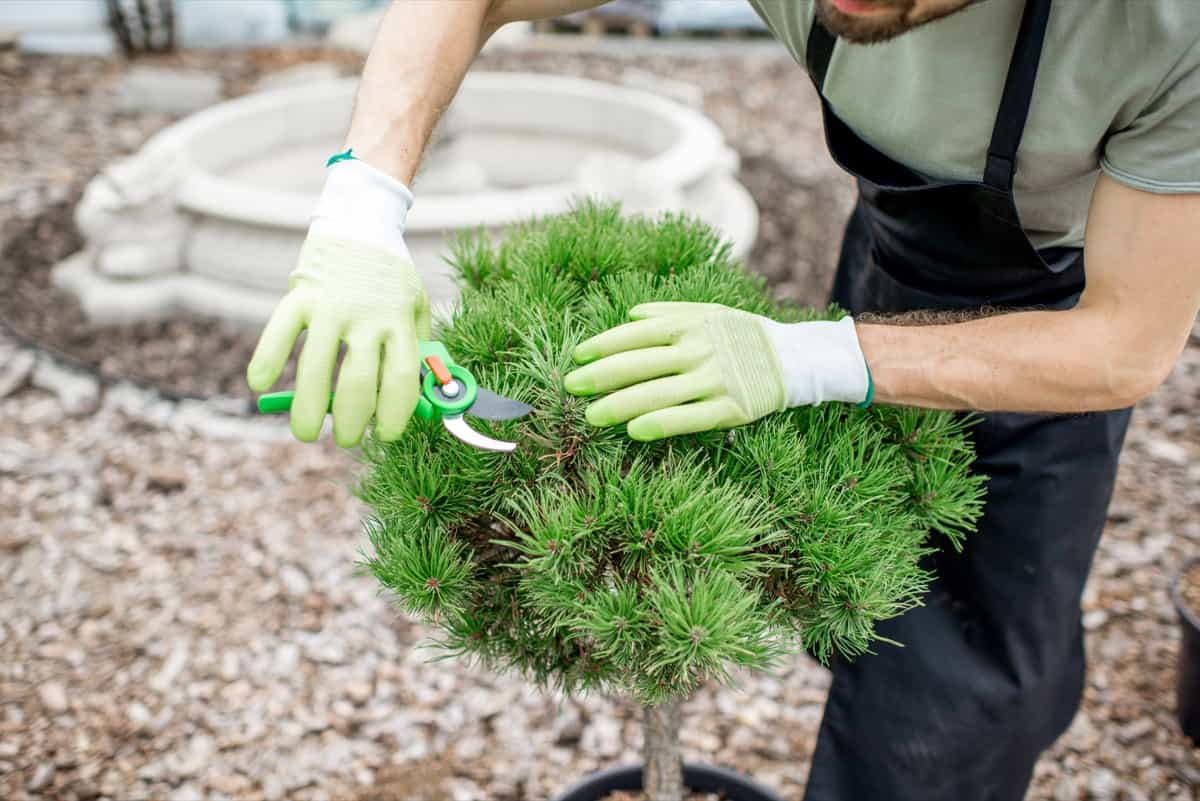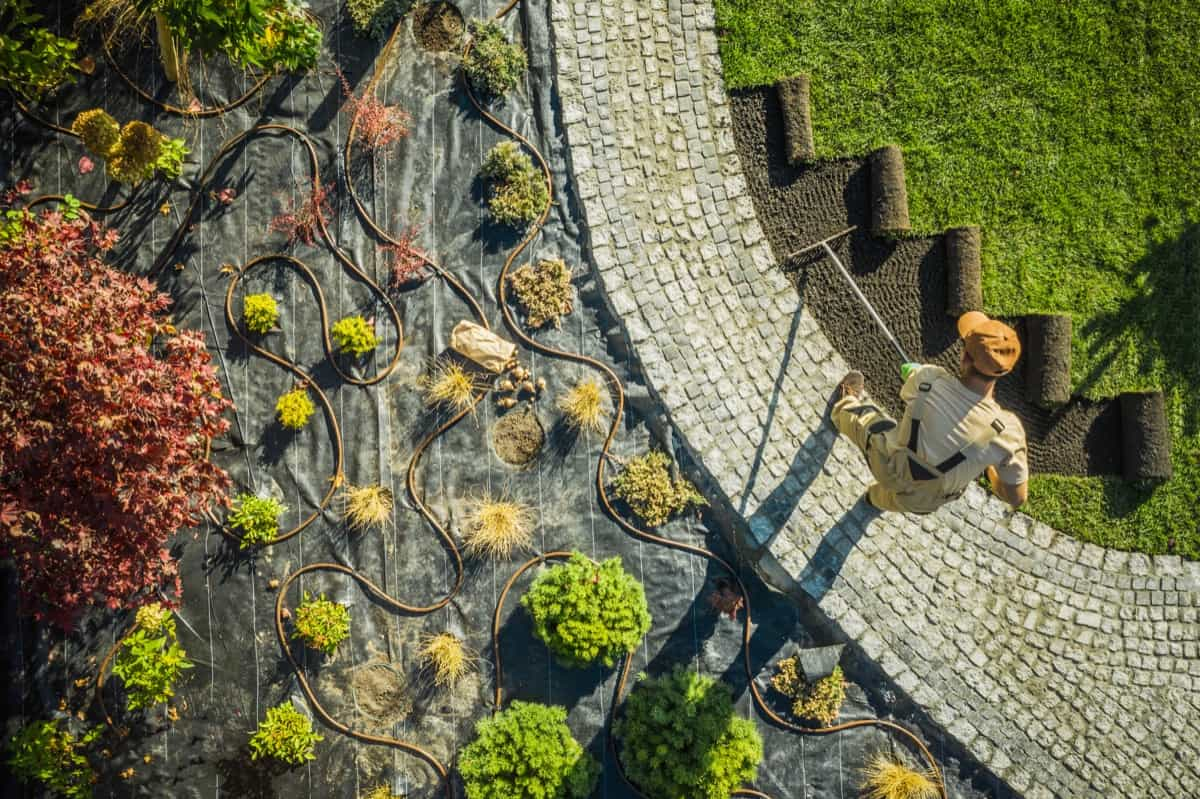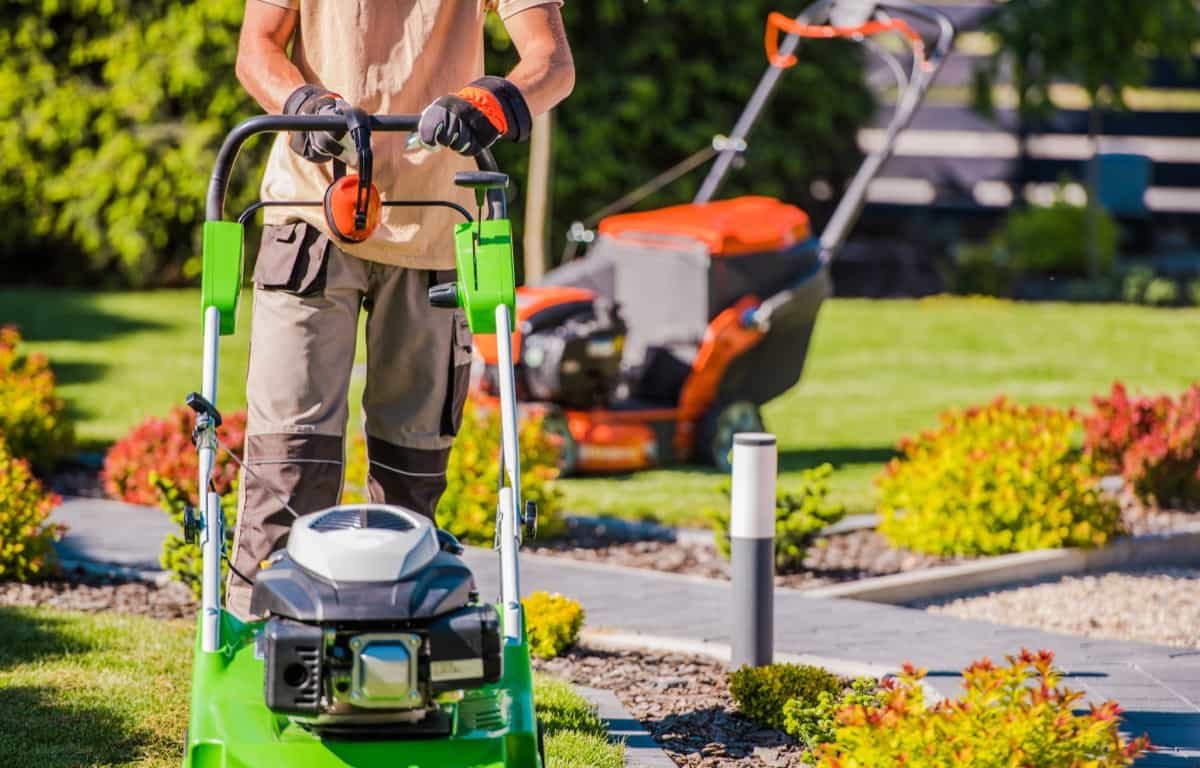Whether you have a small backyard or a sprawling estate, landscaping can transform your outdoor space into a tranquil retreat. Avoiding common landscaping mistakes is crucial if you want to maintain a tidy and beautiful yard. By taking the time to plan your design, select the right plants, and properly care for your landscape, you can create an outdoor space that enhances the beauty of your home.

14 Common Landscaping Mistakes
Neglecting Regular Maintenance
Maintaining a tidy and beautiful yard requires regular maintenance. However, many homeowners need to pay more attention to this crucial aspect of landscaping. By failing to stay on top of routine tasks, like mowing the lawn, weeding flower beds, and trimming shrubs, your yard can quickly become overgrown and unkempt.
One common mistake is forgetting to water your plants regularly. Without proper hydration, they will wither and die, leaving behind unsightly patches in your garden. Additionally, neglecting to fertilize your soil can result in poor plant growth and lackluster colors. Another aspect of regular maintenance that often gets overlooked is cleaning up debris.
Fallen leaves, branches, and other clutter not only create an untidy appearance but also pose a potential hazard for tripping or causing damage during storms. Furthermore, ignoring the need for pest control can lead to infestations that wreak havoc on your landscape. Whether it’s insects invading your flowers or animals digging up your lawn looking for food, taking preventative measures is essential.
Overcrowding Plants and Features
One common landscaping mistake that many homeowners make is overcrowding plants and features in their yards. It’s easy to get carried away with the excitement of gardening and want to fill every inch of space with beautiful blooms, lush greenery, or eye-catching features. However, cramming too many plants or elements into a small area can have a negative impact on the overall aesthetic and health of your landscape.
When plants are placed too close together, they compete for sunlight, water, and nutrients. This can lead to stunted growth, disease susceptibility, and even death. Similarly, overloading your yard with too many features, such as statues, fountains, or decorative structures, can create visual clutter and overwhelm the space.
In case you missed it: Best Grass Alternatives for Your Yard: Guide to Low-Maintenance Landscaping

Each element should be carefully selected and strategically placed to complement one another without overpowering the landscape. To avoid this mistake, take time to plan out your garden beds before planting. When it comes to incorporating features into your yard design, choose items that enhance the overall theme or style while maintaining balance within the space.
Ignoring Proper Plant Spacing
When it comes to landscaping, one of the most common mistakes people make in landscaping is ignoring proper plant spacing. It might be tempting to pack as many plants as possible into a small area, but this can lead to overcrowding and stunted growth. Proper plant spacing is important for multiple reasons. First, it allows each plant enough room to grow and spread its roots without competing with neighboring plants for resources like water and nutrients.
This ensures that each plant has the best chance of thriving in your yard. Adequate spacing also helps prevent disease and pest issues. When plants are too close together, they create a humid environment where diseases can easily spread from one plant to another. Additionally, pests tend to thrive in crowded areas because they have easy access to multiple food sources. Ignoring proper plant spacing can also result in an unattractive landscape.
Failing to Edge Garden Beds
One common mistake that homeowners make when landscaping their yard is failing to edge their garden beds. This may seem like a small detail, but it can make a big difference in the overall appearance of your outdoor space. When you don’t edge your garden beds, the grass and weeds tend to creep into the designated planting areas. This results in a messy and unkempt look that detracts from the beauty of your landscape design.
Proper edging creates clean lines between your lawn and flower or vegetable beds, giving them definition and separation. It not only enhances the aesthetic appeal but also makes maintenance easier by preventing grass and weeds from encroaching on your plants. There are various ways to edge garden beds, depending on your preference and budget.
Using Mismatched or Clashing Hardscape Materials
When it comes to creating a beautiful and cohesive landscape design, the hardscape materials you choose play a crucial role. However, one common mistake that many homeowners make in landscaping is using mismatched or clashing hardscape materials. This can result in a disjointed and chaotic appearance of your yard. Imagine walking into a backyard where the patio is made of sleek modern concrete while the pathways are constructed with rustic cobblestones.
In case you missed it: How to Choose Shrubs for Landscaping: A Beginners Guide

The clash between these two styles can be visually jarring and detract from the overall aesthetic appeal of your outdoor space. To avoid this mistake, take some time to carefully select hardscape materials that complement each other in terms of style, color, and texture. Consider the architectural style of your home as well as any existing elements in your landscape when making these decisions. It’s important to choose materials that not only look good initially but will also stand the test of time.
Neglecting Lawn Care
Neglecting proper lawn care can quickly turn your yard into an unruly mess. One common mistake homeowner make is failing to mow their lawn regularly. Letting the grass grow too tall not only makes it look messy but also weakens the overall health of your lawn. Remember to adjust your mower blades to ensure you’re cutting at the proper height for your grass type.
Another aspect that often gets overlooked is watering. Many people tend to overwater their lawns or rely solely on rain showers. Deep and infrequent watering promotes deep root growth, making your lawn more resilient during dry periods. Applying fertilizer at appropriate times throughout the year provides essential nutrients that promote strong and healthy grass growth.
Poorly Pruned Trees and Shrubs
Proper pruning is essential when it comes to maintaining a beautiful and tidy yard. Yet, one common mistake that many homeowners make is poorly pruning their trees and shrubs. This can not only affect the appearance of your landscaping but also the health of your plants. While it may be tempting to trim back branches excessively, this can actually harm the plant by removing too much foliage and hindering its ability to photosynthesize effectively. Improper technique can result in jagged cuts or damage to the bark of the tree or shrub. It’s important to use sharp tools and make clean cuts at an angle away from the main stem or branch.
Lack of Defined Pathways
One common landscaping mistake that many homeowners need to pay more attention to is creating defined pathways throughout their yards. With clear paths, your outdoor space can feel smooth and organized. Plus, it can be difficult for guests to navigate through your yard without tripping or stepping on delicate plants. Having well-defined pathways not only improves the functionality of your landscape but also adds aesthetic appeal. When designing your pathways, consider using materials that complement the overall style of your garden.
Whether you opt for natural stone, gravel, or pavers, choose a material that matches the theme and vibe of your outdoor space. Another important factor to keep in mind when creating pathways is their size and shape. Make sure they are wide enough for comfortable walking, and consider adding curves or angles to add interest. Straight lines can look too rigid and formal, so feel free to experiment with different shapes. In addition to aesthetics, safety should also be a top priority when planning out pathways.
Ignoring Outdoor Lighting
When it comes to landscaping, many homeowners need to pay more attention to the importance of outdoor lighting. Adequate lighting not only deters potential intruders but also helps prevent accidents by illuminating pathways, stairs, and other potential hazards. Furthermore, well-placed outdoor lights can create a warm and inviting ambiance for your outdoor living spaces.
In case you missed it: Best Grass Alternatives for Your Yard: Guide to Low-Maintenance Landscaping

Proper lighting can set the mood and make your yard more enjoyable. Outdoor lighting also extends the usability of your outdoor spaces into the evening hours. With strategically placed lights, you’ll be able to continue using your patio or deck long after sunset. To avoid this common landscaping mistake, take some time to plan out your outdoor lighting design. Consider highlighting architectural features such as trees or shrubs with spotlights or installing pathway lights along walkways for added visibility.
Not Considering Proportions and Scale
When it comes to landscaping, proportions, and scale are key elements that should never be overlooked. One common mistake homeowner make in landscaping is not considering how the size of plants, trees, or structures will impact the overall aesthetic of their yard. Imagine planting a tiny shrub in front of a towering house; it would look completely out of place and disproportionate.
On the other hand, planting large trees right next to a small patio can create an overwhelming feeling and overshadow the entire space. To achieve balance and harmony in your landscape design, you need to consider the sizes of various elements carefully. Ensure that plants complement one another in terms of height and width.
Think about how they will grow over time – what may seem proportionate now might become overcrowded later. The same goes for hardscape features such as patios or decks. Make sure these structures fit well within your outdoor space without overpowering it. Consider how people will move around them comfortably and if they provide enough seating or entertaining areas for your needs.
Disregarding Seasonal Maintenance
In the spring, for example, failing to clean up debris from winter storms properly can hinder new growth and prevent your plants from thriving. It’s important to remove fallen branches, dead leaves, and any other clutter that may have accumulated over the colder months. Similarly, in the summer, ignoring regular watering and fertilizing routines can leave your lawn looking lackluster and brown. With increased heat and sunlight exposure, grass needs extra care to stay healthy and vibrant.
In case you missed it: Unique Heirloom Fruit Varieties Worth Growing

And let’s remember fall! This season brings with it falling leaves that need to be raked up promptly. Neglecting this task can cause a buildup of decaying foliage, which not only looks unsightly but also creates an ideal breeding ground for pests and diseases. Winter requires some attention as well. Failing to protect delicate plants or properly clear snow from walkways can result in damage that may be costly or even irreversible come springtime.
Allowing Weeds to Thrive
Allowing weeds to take hold not only detracts from the overall beauty of your yard but it also competes with your desired plants for nutrients, sunlight, and water. Before you know it, those pesky invaders have taken over, choking out any chance of flourishing flowers or lush green grass. To combat this issue, it’s essential to stay vigilant and tackle weed control head-on.
Regularly inspect your yard for any signs of unwanted intruders and promptly remove them before they have a chance to establish themselves. Pulling weeds by hand or using appropriate weed-killing solutions are effective methods to keep these unwelcome guests at bay. Mulching garden beds helps suppress weed growth by blocking sunlight access while retaining moisture for your desirable plants.
Using Too Many Lawn Ornaments
Using too many lawn ornaments can be tempting, especially with so many cute and quirky options available. However, it’s important to exercise restraint when it comes to decorating your yard. While a few well-placed ornaments can add personality and charm, an excess of them can quickly become overwhelming. When there are too many lawn ornaments scattered throughout your yard, the overall aesthetic can become cluttered and chaotic.
Instead of creating a visually appealing space, you may end up with a jumble of mismatched objects that distract from the natural beauty of your landscaping. Additionally, using too many lawn ornaments can make maintenance more difficult. These decorations often require cleaning and upkeep to keep them looking their best.
With an abundance of ornaments, this task becomes time-consuming and tiresome. Furthermore, having an excessive number of lawn ornaments can detract from the intended focal points in your yard. Instead of drawing attention to beautiful flower beds or architectural features like fountains or statues, all eyes will be drawn to the cluttered collection of decorations.
Forgetting About Drainage Issues
One common landscaping mistake that homeowners often need to remember is the importance of addressing drainage issues. When maintaining a beautiful yard, proper drainage is key. Without it, you may find yourself dealing with soggy patches of grass or, even worse – standing water that can damage plants and attract pests. Ignoring drainage problems can lead to a whole host of issues. Excess water can drown your plants’ roots, causing them to rot and die.
It can also create muddy areas that are not only unsightly but also make it difficult for you and your family to enjoy your outdoor space. To avoid these problems, it’s crucial to assess the natural flow of water in your yard and implement strategies to redirect it appropriately. This might involve installing drains or grading the land so that water flows away from vulnerable areas.
In case you missed it: How to Make Grass Clippings Compost Fertilizer: Homemade Recipe, DIY for Container, Indoor, and Backyard Garden Plants

Additionally, consider using porous materials such as gravel or permeable pavers for walkways and patios. These materials allow water to seep through instead of pooling on the surface. Make sure they are clear of debris so that rainwater can be directed away from your foundation and into appropriate drainage systems.
Conclusion
By avoiding these common landscaping mistakes, you can maintain a tidy and beautiful yard that you can be proud of. Take the time to carefully plan the placement of outdoor structures and features carefully, ensuring they enhance rather than hinder the overall aesthetic. Always consider the long-term implications of your landscaping choices.
Think about how plants will grow over time, how trees may shade certain areas in the future, or how outdoor structures may impact sunlight patterns. By paying attention to these details and being proactive in maintaining your yard’s appearance, you can create an inviting outdoor space that adds value to your home while providing a relaxing environment for you and your family.
- How to Grow Hibiscus from Flower
- Plantation Ideas for Home Decoration: A Beginners Guide
- Flower Garden Designs and Layouts for Beginners
- Planting and Spacing Techniques in Papaya: A Beginner’s Guide
- Growing Gold: Essential Techniques for Planting Pineapples
- How to Make Kalanchoe Plant Bushy: Home Remedies and Solutions
- 11 Reasons Why Your Gardenia is Not Blooming: Home Remedies and Solutions
- Eco Elegance: The Guide to Designing a Drought-Tolerant Landscape
- Gardening on a Slope: Strategies for Hillside Landscaping
- Nourish and Flourish: Top Organic Mulches for Thriving House Plants
- Everything You Want to Know about Indian Mogra Flower: Discover Uses and Growing
- Green Thumb Success: Expert Tips for Cultivating Greenhouse Pumpkins All Year Round
- Maximize Growth & Flavor: The Ultimate Guide to Companion Planting in Herb Gardens
- How to Control Rhododendron Problems Naturally: Home Remedies and Organic Ways to Fix Them
- Natural Magic: The Remarkable Benefits of Cinnamon for Plants
- Best Steps to Revive Dying Tulip with Natural and Organic Treatment
- 10 Reasons Why Your Angel Trumpet is Not Blooming: Remedies and Treatment
- How to Fix Periwinkle Leaf and Flower-Related Problems: Natural Remedies and Solutions
- How to Fix Zinnias Leaf and Flower Problems: Discover Natural and Home Remedies
- Organic Steps to Induce Lemon Tree Flowers: A Comprehensive Guide
- Bloom Booster: Crafting the Perfect Homemade Bougainvillea Fertilizer
- Optimizing Growth: A Guide to Applying NPK Fertilizer for Potted Plants
- 10 Best Homemade Fertilizers for Rubber Plant: DIY Recipes and Application Method
- How to Boost Female Pumpkin Flowers: Effective Steps for More Flowers and High Yields
- Transform Your Indoor Garden: Top Benefits of Pink Salt for Houseplants
- 10 Best Homemade Fertilizers for Peacock Plants (Calathea): Easy DIY Guide
- Unlock Blooms: 9 Reasons Why Your Potted Chrysanthemum is Not Blooming
- 8 Reasons Why Your Potted Hibiscus is Not Blooming: Fix it with Simple Solutions
- Unlock Blooms: 9 Key Reasons Your Potted Frangipani Won’t Flower
- 10 Reasons Why Is My Ice Plant Not Blooming: Remedies and Treatment
- 10 Reasons Why My Potted Hydrangea Not Blooming: Treatment and Remedies
- 10 Reasons Why is My Wisteria Not Blooming: Remedies and Treatment
- 10 Reasons Why is My Goldfish Plant Not Blooming: Remedies and Treatment
- Maximize Your Space: Ultimate Guide to Balcony Gardening with Grow Bags
- 10 Reasons Why Your Iris is Not Blooming: Remedies and Treatment
- 10 Reasons Why Your Anthurium Plant is Not Blooming: Treatment and Remedies